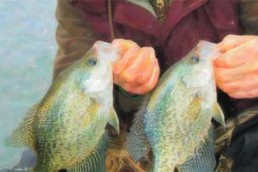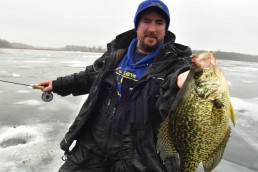A Quiet, Technological Approach for First-ice Success
SHARE THIS POST
The leaves and water temperatures are starting to fall. This can only mean one thing: ice will soon be upon us. This is not the time to put the boat away quite yet. One of the most important tasks for a successful ice season is what happens from fall until ice-up. Preparation and scouting on the open water with a boat will give you a better idea of where to start once the ice forms.
It does take a lot to make it a more successful ice season, especially for that first ice.
I recently had back surgery, and as I was sitting in the recovery room I was thinking about ice fishing and how the preparation for my surgery related to my preparation for the ice. The doctors have all kinds of imaging equipment and tools to find the spot where they need to operate. They use all these images to precisely cut into my spine and get the work done.
Could you imagine if they did not have those images? I would be cut to pieces, holes everywhere and who knows if they would have found the problem.
We’re fortunate to have technology with fishing today too. There’s mapping software and GPS units that record live-depth soundings in areas that may not have any charts available or are lacking the detail.
As water temperatures cool, panfish tend to head back to shallow bays with weeds or similar spots where they were back in spring. However, over the summer weed growth and currents change contours where fish hang out.
With the use of my Raymarine multi-function locator and the Navionics SonarCharts Live, I’m able to scan the bays, lakes, rivers and channels and record depth soundings live as I travel over the tops of areas. These “sonar logs” are then uploaded wirelessly through my phone or the Raymarine units themselves to Navionics where they will take the data, smooth it out and release it to everyone who has a Navionics Live chart or the Navionics app on their smartphone or tablet. From there, we can precisely find the pockets, weed edges or new transitions that will hold fish come first ice, which in turn makes the searching for them more efficient.
One of the biggest keys for success is to do your own thing. Granted, there are community spots, and yes, they will produce fish, but I can guarantee anyone who has ever fished these spots realizes it’s a short-lived area—one person tells two buddies and those two buddies tell four buddies and so on. When you find a fresh spot, keep quiet and try not to draw a lot of attention to that area. If I get on a good bite early or even late in the season, I will never fish it two days in a row. And, I’ll hardly ever fish a good spot on a weekend where many are looking. The reward for a couple days of searching and locating that unpressured school of fish is extremely satisfying.
Finding the fish is half the battle. Once you do, having the proper tools makes up the other half. First ice can have some of the best fishing of the year. Typically, the fish have not been targeted for a couple of months and are pretty relaxed. The goal is to not spook them out of these shallow areas. And the use of the new ION X electric ice auger can quietly and quickly drill holes in precise spots without any noise and vibration of a gas auger.
Are you enjoying this post?
You can be among the first to get the latest info on where to go, what to use and how to use it!
Once the holes are drilled, a lot of anglers like to fish out of portable shelters. I love being warm and comfortable, but sometimes pulling a shelter around can spook the fish. I typically stack all my gear into my Eskimo Wide-1 and pull that into the area I fish and set it up on a hole and use that for my base camp. In there, I’ll tie new baits or warm the fingers, but the majority of the time I will move around and “hole-hop” around an area that I drilled plenty of holes when I first got to the spot. A big part of catching fish is also being comfortable, and a crucial element. If you’re warm and comfortable you’re more likely to take the time to try new baits or new areas. If the cold sets in, the next move is typically back to the truck.
Once you start fishing, remain as quite as possible. One thing I often see during first ice when not much snow is present is the use of creepers. I will wear them while pulling my gear out to an area, but once I’m there, I will take them off. The noise is pretty substantial, and as I mentioned, staying as quiet as possible is important. I often use my 6-inch auger and leave some slush in the holes for less light penetration. I find bluegills, perch and crappies can sometimes be skittish around the larger holes in shallow areas where light penetrates like a spotlight.
If you’re targeting crappies and perch, another product I find effective is the Bite Me Box Tip Up. These boxes keep all the light out and are incredibly sensitive for light-biting perch or crappies. Not only does it keep the light out, but it also doesn’t produce the shadows or noise a person makes while fishing over a hole. I have had days where we could not get a bite jigging, but the boxes put fish on the ice constantly.
While hole-hopping, I prefer the longest rod I can get. The 13 Fishing 42-inch Light Action Hole Hopper paired with the new 13 Fishing Free Fall Reel gives me the ability to see the light bites with the super-sensitive tip, yet keep me away from the hole with length of the rod. That means no shadows or noise directly over the hole.
Line can also be a benefactor for early-season fishing. Most water this time of year has become very clear so a good fluorocarbon is necessary. I have been impressed with the Seaguar AbrazX Ice fluorocarbon line. It’s a very soft, pliable line with hardly any memory retention. The strength-to- diameter ratio is better than most lines I’ve fished with and the knot strength and abrasion resistance is incredible for the ultralight 2- and 3-pound-test versions.
Having the right gear and knowing how to use it effectively and efficiently will help you find and catch more fish. Go prepared, stay comfortable and experiment with new baits in new areas. You will become a more successful angler not only during first ice, but also throughout the season. Just remember to keep quiet when you land on that mother lode.
Troy Peterson, “Mr. Bluegill,” owns and runs Mr. Bluegill Guide Service out of Oshkosh, Wis., and grew up on Lake Winnebago and has been fishing the system his entire life. You can view his weekly reports with instructional videos on his website, mrbluegill.com, as well as a weekly column on the Gannett newspaper website, wisconsinoutdoorfun.com. Peterson is also a member of the Association of Great Lakes Outdoor Writers and delivers seminars across the Midwest. To see videos on how to jig for walleyes including different baits and rod setups, visit Troy Peterson’s YouTube Channel: youtube.com/mrbluegill.
MWO
SHARE THIS POST
Did you enjoy this post?
You can be among the first to get the latest info on where to go, what to use and how to use it!
Troy Peterson
Troy Peterson, “Mr. Bluegill,” owns and runs Mr. Bluegill Guide Service out of Oshkosh, Wis., and grew up on Lake Winnebago and has been fishing the system his entire life. You may view his weekly reports with instructional videos on his website, mrbluegill.com, as well as a weekly column on the Gannett newspaper website, wisconsinoutdoorfun.com. Peterson is also a member of the Association of Great Lakes Outdoor Writers and delivers seminars across the Midwest. To see videos on how to jig for walleyes including different baits and rod setups, visit Troy Peterson’s YouTube Channel: youtube.com/mrbluegill.




